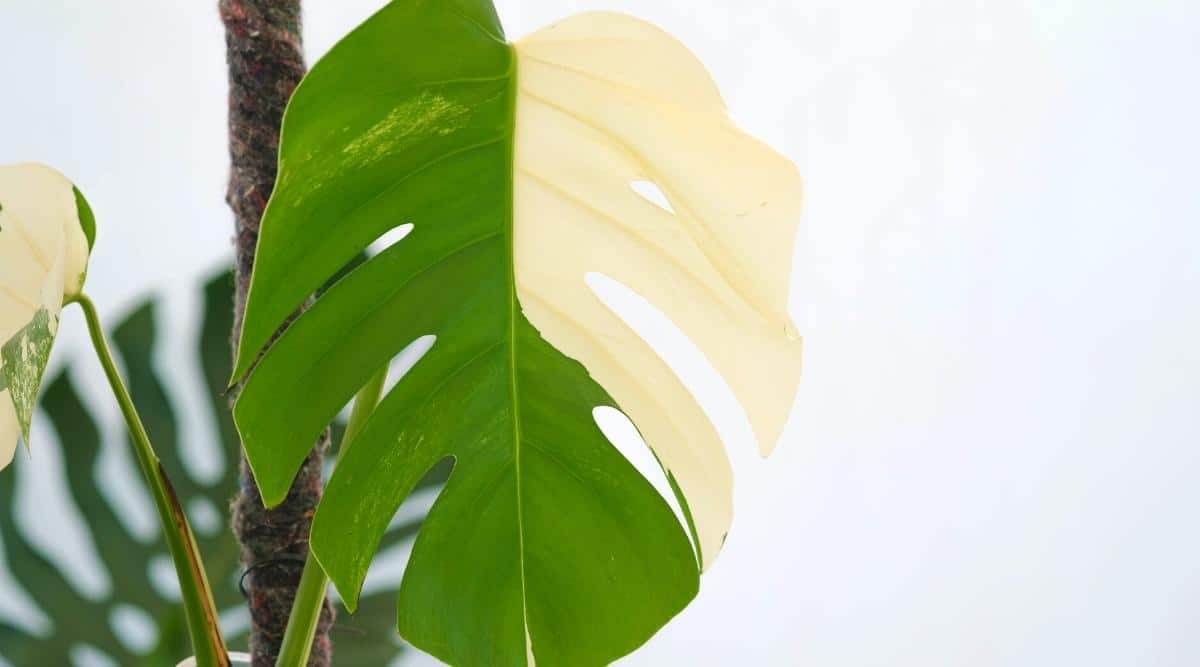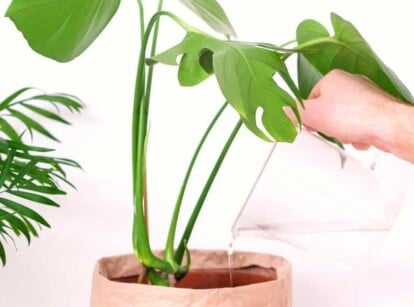11 Reasons Why You Need a Variegated Monstera Plant
Are you looking for another unique houseplant to add to your collection? You may not thing of monsteras as incredibly unique, but what about if you add a little leaf variegation? In this article, gardening expert and houseplant enthusiast Madison Moulton walks through 11 reasons why you'll love adding a variegated monstera to your houseplant collection!

Contents
You can’t scroll through gardening social media pages without seeing at least one variegated Monstera plant. Topping the list of most famous houseplants, variegated Monsteras are loved around the world for many reasons, besides the obvious – their gorgeous leaves.
Yes, there are certainly more rare variegated houseplants, like the Pink Princess Philodendron. But you should expect to pay a premium for them, and they won’t likely be readily available locally. In the variegated monstera, you get a more budget-friendly and visually stunning houseplant.
In celebration of these rare beauties, we’ve rounded up 11 reasons you should love variegated Monstera plants (in case you don’t already). It may be a little harder to find the perfect plant, but after taking a look at the reasons they are so visually appealing, you’ll understand why it’s worth the effort!
Fascinating Coloring

By far the biggest reason to love variegated Monsteras is their stunning colors. Variegated indoor plants are highly sought after thanks to their patterns and often, their rarity. Caused by genetic mutations, stable variegation is a fascinating phenomenon that is as interesting inside the cells of the plant as it is to look at.
No variegated plant has taken the world by storm more than the Monstera. Large areas of white, and often entirely white leaves, appear in varieties like ‘Albo variegata’ and the more modest ‘Thai Constellation’. No other houseplant has variegation quite like the Monstera, making them one of the most sought-after collectibles around the world.
The key to maintaining this coloring is sunlight. As variegated areas lack chlorophyll, the plant has less capacity for photosynthesis – an essential process for survival. If the light levels are too low, the plant will start to produce more chlorophyll to make up for the deficit, turning once variegated areas green again. Place them in an area with bright indirect sunlight for the entire day to keep this coloring alive.
Rarity

Despite their wide popularity and fame, variegated Monsteras can be difficult to find. They are certainly easier to find now than when they first went viral a few years ago, but you’re unlikely to come across one when casually strolling through your local garden center.
This rarity is largely due to the amount of time it takes to produce new plants. Maintaining the variegation levels from one variety is done by propagating from cuttings. Unfortunately, it takes time for these individual cuttings to turn into established and healthy plants that look good enough to sell.
As these plants are propagated and spread further, they have become easier to find – and much cheaper too. But for now, some variegated cultivars retain their rare status, making them all the more special when added to your collection.
Collectible Nature

These popular plants are so sought after that they’ve become the ultimate collector’s item. Houseplant collections are huge, with many committed indoor gardeners looking for that indoor jungle aesthetic popularized online.
As houseplant growing has become far more common, those who’ve mastered popular favorites like ZZ Plants and Fiddle Leaf Figs are looking for something a little different, perhaps a little more challenging. And in houseplant collections, variegated Monsteras are the most prized possession of them all.
To complement your variegated Monstera, why not add a few other rare monstera varieties to your indoor garden? Other species like Monstera adansonii and Monstera obliqua are perfect companions.
Tropical Feel

Monsteras are native to the tropical rainforests of Central America, using their aerial roots to climb up trees and cover trunks with large leaves. This is what makes them such great houseplants – they enjoy similar conditions to what can be found in our homes. This leafy look also adds an instant tropical feel to your home anywhere they are placed.
There is a reason why Monstera leaf motifs have become so popular on everything from wallpapers to throw pillows and more. Add variegation to this tropical look and you have an unbeatable combination. Even better, throw in a few more tropical beauties – particularly palms – to make your own tropical paradise indoors.
Ability To Climb

Another reason you’ll love these plants can be easy to overlook. This reason is their ability to climb. Although smaller plants can usually stand on their own, larger species grow far better with a bit of help. Providing support not only speeds up growth by replicating growth in their natural habitats but also improves the health of the plant by reducing overcrowding and improving airflow.
This ability can be used to your advantage to create impressive indoor features. Add a moss pole to the container when planting or repotting to improve humidity and help them reach new heights. You can also train the vines up a trellis or shelf to create a living wall feature. It may take a while to fill out, but it will certainly be a statement once it has grown.
When securing vines to any kind of support, make sure you use flexible ties or fabric scraps rather than stiff wire. Plants are constantly moving and any inflexible ties can cut into the vine, damaging the plant and exposing it to potential pests and diseases. When dealing with a rare variety, that is the last thing you’ll want.
Impressive Size

If you’re looking for a plant that can quickly fill a corner, a variegated Monstera is your answer. These plants have stunning leaves that can quickly grow larger than the size of your hand or even more in the right environment. As leafy plants are the most sought-after of all the houseplants, it’s easy to see why Monsteras are so famous.
To make sure the leaves grow as large as possible, it’s important to give your plant the best possible care. This will help them grow to their full potential in leaf size and amount of leaves too.
The first consideration is sunlight. Giving these plants bright indirect light will keep photosynthesis rates high, giving the plants the energy required to grow successfully.
Secondly, they need enough water. Monsteras love moist soil, but also can’t sit in soggy soil as this will lead to rotting. Water when the top layer of soil has just dried out and provide adequate drainage to keep them happy.
Finally, make sure they have enough nutrients to expand by fertilizing regularly during spring and summer. A balanced fertilizer at half strength applied according to instructions should be enough to keep these plants larger than life year after year.
Fenestration

The Monstera genus stands out among other tropical plants for the holes in their leaves. This is the reason for their somewhat comical common names, including the most well-known one – Swiss Cheese Plant.
These holes are the result of fenestration, and scientists aren’t quite clear on why Monsteras in particular evolved this way. The theory is that these holes increased the surface area of the leaves, allowing them to capture as much sunlight as possible under the shade of tree canopies above.
As this quality is so special, making sure your Monstera develops those uniform holes is an important task. Unfortunately, many new Monstera owners find leaves emerging without any fenestration or even splits at all, ruining the classic Monstera look (especially in variegated types).
To make sure your plant develops as many holes as possible, give them adequate sunlight. Monsteras placed in low light will stop developing holes or splits and will remain solid.
Also remember to rotate the pot frequently so all parts of the plant receive equal amounts of sunlight. If you forget, you’ll notice the leaves closest to the light source developing holes while those on the other side of the plant remain solid, becoming unbalanced.
Tolerance of Shade

All Monstera species are found growing under the shade of trees in their native habitats. Their love of shade is just one of the reasons why they make such great indoor plants.
You don’t need full sun spots, or even any direct sun, for these plants to grow to their full potential. In fact, direct sun can actually damage the foliage, leaving unsightly brown marks. As long as you have a sunny room with an east or west-facing window and space out of the path of any harsh sunlight, this plant will grow happily for years indoors.
Quick Growth

Although variegated Monsteras do grow slightly slower than non-variegated varieties, they are still considered quick growers in the houseplant world. These plants regularly put out new leaves and extend their vines, especially when given some support.
Within a few years, a young plant can grow to impressive heights with very little effort. This also means you can prune them regularly to propagate without impacting size too much, giving you even more of your favorite plants at great speeds.
Limited Pest & Disease Problems

Pests and diseases are something every gardener wants to avoid. Although these issues are more prevalent outdoors than they are indoors, houseplant owners are not immune to problems. Luckily, with these plants you’re unlikely to encounter serious problems that kill your plant.
With the right care, your plants can fight off most problems with ease. And, as long as you avoid bringing any pests indoors from other plants or spreading them around your space, pests aren’t likely to strike either. The only issue to watch out for is root rot. This can be managed by watering at the right times and ensuring adequate drainage in the pot and soil.
Easy To Propagate

The last reason on the list is also my favorite one – variegated Monsteras are incredibly easy to propagate. As they are tough to find and quite expensive, you’re likely to be propagating these stunning plants year-round if you want to get more of them.
To do this, all you need to do is take a stem cutting with one or two aerial roots and a few leaves and pop them in a glass of water to develop roots. From there, transplant into a light houseplant potting mix. Once done, you’ll have a brand new plant without spending a cent.
You can even keep the cuttings in water long-term to create a captivating décor feature. Simply add a few drops of fertilizer to the water and keep it clean to prevent bacterial build-up. Your living feature will live for several months without fuss, even producing new leaves in the growing season.
Final Thoughts
So, now that you’ve learned why you should welcome a variegated monstera into your home, the only thing to do is to go and find the perfect plant! They can be found by many online houseplant retailers, but are likely carried by local houseplant stores as well. There are many varieties to choose from, so take your time, and find your perfect match!









